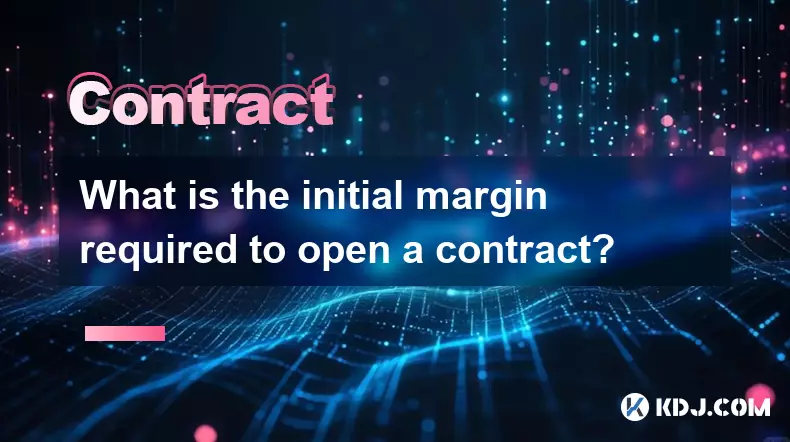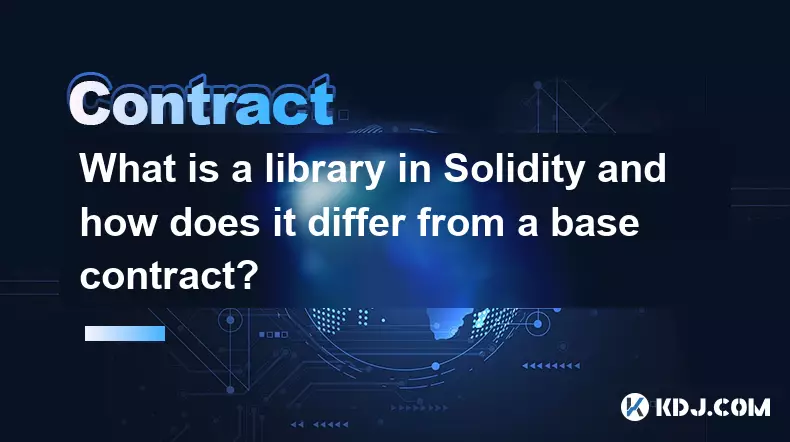-
 bitcoin
bitcoin $103128.103252 USD
-3.33% -
 ethereum
ethereum $3437.127692 USD
-4.86% -
 tether
tether $0.999700 USD
-0.02% -
 xrp
xrp $2.403993 USD
-5.73% -
 bnb
bnb $961.374676 USD
-4.11% -
 solana
solana $154.938665 USD
-8.18% -
 usd-coin
usd-coin $1.000113 USD
0.03% -
 tron
tron $0.298122 USD
0.30% -
 dogecoin
dogecoin $0.172428 USD
-5.76% -
 cardano
cardano $0.557625 USD
-7.13% -
 hyperliquid
hyperliquid $38.740701 USD
-6.51% -
 chainlink
chainlink $15.306051 USD
-7.51% -
 bitcoin-cash
bitcoin-cash $507.558648 USD
-3.26% -
 stellar
stellar $0.281899 USD
-6.74% -
 unus-sed-leo
unus-sed-leo $9.241811 USD
0.57%
What is the initial margin required to open a contract?
Initial margin in crypto derivatives is the collateral needed to open a leveraged position, varying by asset, leverage, and exchange—higher volatility or leverage means higher risk and lower margin requirements.
Nov 06, 2025 at 03:49 am

Understanding Initial Margin in Crypto Derivatives
1. The initial margin is the amount of funds a trader must deposit to open a leveraged position in a futures or perpetual contract. This serves as collateral to cover potential losses and ensures market stability. In the cryptocurrency derivatives space, exchanges set varying requirements depending on the asset, leverage level, and risk parameters.
2. For most major platforms such as Binance, Bybit, or OKX, the initial margin is expressed as a percentage of the total position value. For instance, opening a $10,000 BTC/USDT perpetual contract with 10x leverage requires an initial margin of $1,000. This reflects a 10% margin rate, which aligns with standard industry practices for moderate leverage tiers.
3. Different cryptocurrencies carry different volatility profiles, leading to adjustments in margin requirements. High-volatility altcoins often demand higher initial margins compared to stablecoins or large-cap assets like Bitcoin and Ethereum. Exchanges implement these variations to mitigate systemic risk during sharp price swings common in the crypto markets.
4. Traders can choose their leverage level, directly influencing the initial margin needed. A higher leverage reduces the required upfront capital but increases liquidation risk. For example, switching from 5x to 25x leverage on a $5,000 position lowers the initial margin from $1,000 to $200, making the trade more capital-efficient yet significantly more sensitive to adverse price moves.
5. Some platforms offer dynamic margin systems where the required deposit adjusts based on real-time market conditions. During periods of high volatility or low liquidity, exchanges may temporarily increase initial margin rates across certain contracts to protect both users and the platform’s financial integrity.
Risk Management and Margin Calls
1. Once a position is open, the account must maintain a minimum maintenance margin. If the equity in the account falls below this threshold due to unfavorable price movements, a margin call occurs. At this stage, traders must deposit additional funds or face automatic liquidation.
2. Failure to meet a margin call results in forced closure of the position by the exchange, often at a loss. This mechanism protects the platform from covering losses on behalf of traders and maintains fairness within the trading ecosystem.
3. Risk management tools such as stop-loss orders and partial close strategies help traders preserve their margin balance. These features are widely supported on modern crypto derivatives platforms and allow users to automate responses to rapid market changes without constant monitoring.
4. Cross-margin and isolated margin modes influence how initial margin is allocated. In isolated mode, only the designated margin amount is at risk, while cross-margin uses the entire wallet balance as collateral, increasing exposure but reducing the chance of sudden liquidation.
5. Understanding the difference between these modes is essential for managing risk effectively. Isolated margin provides predictability, whereas cross-margin offers flexibility at the cost of broader fund exposure.
Platform-Specific Margin Policies
1. Leading exchanges publish detailed margin requirement tables for each tradable pair. These documents outline initial and maintenance margin ratios, funding rates, and maximum allowable leverage, allowing traders to plan entries with precision.
2. Regulatory frameworks in certain jurisdictions impact margin offerings. For example, U.S.-based platforms like Kraken Futures adhere to CFTC guidelines, limiting leverage and adjusting margin rules accordingly. International platforms may offer more aggressive terms due to less restrictive oversight.
3. Traders should verify margin specifications directly on the exchange interface before placing orders, as values can change without notice during volatile events. Relying on outdated information may lead to unexpected position rejections or immediate liquidations.
4. Tiered fee structures and VIP programs sometimes include benefits related to margin efficiency. Higher-tier users might access lower initial margin requirements or enhanced leverage options, improving capital utilization for active traders.
5. Community forums and official announcements serve as valuable resources for tracking updates to margin policies. Sudden shifts in requirements often follow significant market crashes or regulatory interventions, making awareness critical.
Frequently Asked Questions
What happens if my position gets liquidated?When a position is liquidated, the exchange automatically closes it to prevent further losses beyond the available margin. A portion of the margin may be used to cover transaction costs or insurance fund contributions, depending on the platform's policy.
Can I add more margin after opening a position?Yes, traders can increase their margin manually after opening a position. This action improves the maintenance buffer and reduces the likelihood of liquidation, especially useful during turbulent price movements.
How is initial margin calculated for inverse contracts?Inverse contracts, settled in cryptocurrency rather than fiat or stablecoins, calculate initial margin in the base currency. For example, a BTCUSD futures contract requires BTC as margin, and its value is derived from the notional amount divided by the leverage applied.
Do all crypto derivatives require the same initial margin?No, initial margin varies across contract types, underlying assets, and exchanges. Options, futures, and perpetual swaps each have distinct margin models influenced by volatility, time decay, and funding mechanisms unique to their structure.
Disclaimer:info@kdj.com
The information provided is not trading advice. kdj.com does not assume any responsibility for any investments made based on the information provided in this article. Cryptocurrencies are highly volatile and it is highly recommended that you invest with caution after thorough research!
If you believe that the content used on this website infringes your copyright, please contact us immediately (info@kdj.com) and we will delete it promptly.
- Ethereum, Altcoins, and Long-Term Gains: Navigating the Crypto Landscape
- 2025-11-12 09:00:00
- Strategy Shares, Bitcoin Retreat, and Market Pain: A NYC Perspective
- 2025-11-12 08:55:01
- Taft, Veterans, and Salutes: A Presidential Honor
- 2025-11-12 09:00:00
- Cryptos, Breakout, and Meme Coins: What's the Haps?
- 2025-11-12 09:40:01
- Altcoin Uprising: Nano, Velodrome, and the Dawn of Practical Crypto
- 2025-11-12 08:40:01
- Dogwifhat (WIF) Price Analysis: Navigating the Breakout Zone
- 2025-11-12 09:20:01
Related knowledge

What is a Denial of Service (DoS) attack in a smart contract and what are its common forms?
Nov 10,2025 at 05:20am
Understanding Denial of Service in Smart Contracts1. A Denial of Service (DoS) attack in the context of smart contracts refers to a scenario where a m...

What is a cryptographic nonce used for in transaction signing?
Nov 11,2025 at 05:59am
Understanding Cryptographic Nonces in Blockchain Transactions1. A cryptographic nonce is a random or pseudo-random number used only once in the contex...

How does inheritance work in Solidity smart contracts?
Nov 11,2025 at 10:40pm
Inheritance in Solidity: Building Modular Smart Contracts1. Inheritance in Solidity allows one contract to adopt the properties and functions of anoth...

What is a Minimal Proxy Contract (EIP-1167) and how does it save gas on deployment?
Nov 12,2025 at 11:39am
What is a Minimal Proxy Contract (EIP-1167)?1. A Minimal Proxy Contract, standardized under Ethereum Improvement Proposal (EIP) 1167, is a lightweight...

What is a library in Solidity and how does it differ from a base contract?
Nov 12,2025 at 09:19am
Understanding Libraries in Solidity1. A library in Solidity is a special type of contract designed to hold reusable functions that can be shared acros...

How do you safely send Ether to another contract?
Nov 09,2025 at 06:40pm
Sending Ether to Smart Contracts: Key Considerations1. Verify that the receiving contract has a payable fallback function or a designated payable func...

What is a Denial of Service (DoS) attack in a smart contract and what are its common forms?
Nov 10,2025 at 05:20am
Understanding Denial of Service in Smart Contracts1. A Denial of Service (DoS) attack in the context of smart contracts refers to a scenario where a m...

What is a cryptographic nonce used for in transaction signing?
Nov 11,2025 at 05:59am
Understanding Cryptographic Nonces in Blockchain Transactions1. A cryptographic nonce is a random or pseudo-random number used only once in the contex...

How does inheritance work in Solidity smart contracts?
Nov 11,2025 at 10:40pm
Inheritance in Solidity: Building Modular Smart Contracts1. Inheritance in Solidity allows one contract to adopt the properties and functions of anoth...

What is a Minimal Proxy Contract (EIP-1167) and how does it save gas on deployment?
Nov 12,2025 at 11:39am
What is a Minimal Proxy Contract (EIP-1167)?1. A Minimal Proxy Contract, standardized under Ethereum Improvement Proposal (EIP) 1167, is a lightweight...

What is a library in Solidity and how does it differ from a base contract?
Nov 12,2025 at 09:19am
Understanding Libraries in Solidity1. A library in Solidity is a special type of contract designed to hold reusable functions that can be shared acros...

How do you safely send Ether to another contract?
Nov 09,2025 at 06:40pm
Sending Ether to Smart Contracts: Key Considerations1. Verify that the receiving contract has a payable fallback function or a designated payable func...
See all articles


























![[4K 60fps] no care by crashpancake2 (1 Coin) [4K 60fps] no care by crashpancake2 (1 Coin)](/uploads/2025/11/12/cryptocurrencies-news/videos/6913a8862890b_image_500_375.webp)














































